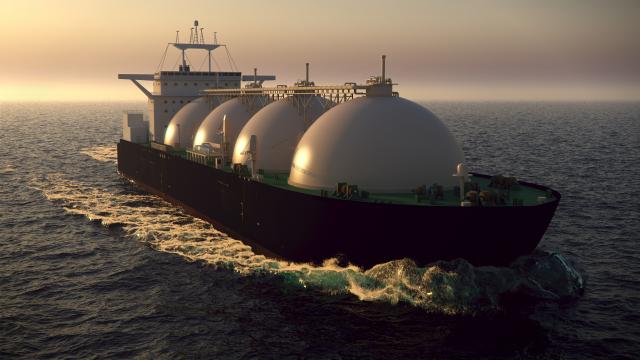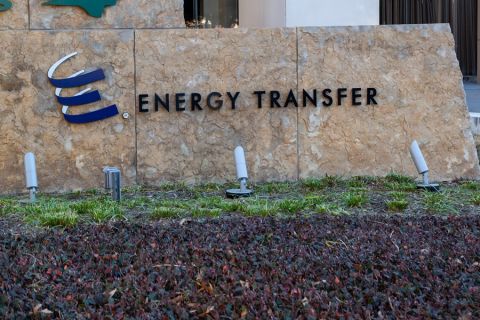
Gas tanker floating in the ocean. (Source: Shutterstock)
America’s LNG exporters are unveiling efforts to slash carbon emissions from new facilities as they look to keep new multibillion-dollar projects on track amid mounting climate pressures.
The U.S. has emerged as an LNG export powerhouse in recent years thanks to explosive growth from the country’s shale oil and gas fields, emboldening American claims of energy independence and handing Washington a useful new tool to counter geopolitical foes such as Russia.
But for a handful of companies racing to build new projects that could propel the nation’s exports yet higher, the global crackdown on emissions and heightened focus on methane pollution from U.S. oil and gas fields has threatened to derail their plans.
European efforts to implement a carbon border adjustment tax—which could levy a fee for higher emitting imports—is of particular concern for U.S. LNG companies that compete with Russia, Qatar and others on the continent.
U.S. LNG project developers have looked to counter the threat by rolling out plans to install costly equipment to capture carbon from their facilities, among other measures such as pledging to secure gas only from producers monitoring their own emissions.
In May, LNG project developer Venture Global said it plans to install carbon capture and storage equipment that could eventually trap as much as 1 million tonnes a year of CO2 from a new $5.8 billion export plant it is building on the Gulf Coast in Louisiana and another it hopes to approve this year.
That came after a similar announcement in March from project developer NextDecade, which said it had added plans to capture and store about 90% of the CO2 emissions from its proposed $8 billion Rio Grande export site in Texas. It hopes to take a final investment decision on the project this year.
Cheniere Energy, the largest U.S. LNG exporter, says it will provide buyers with emissions data for each of its shipments from next year.
Carbon capture and storage, where CO2 is trapped at the site and piped to natural reservoirs deep underground for storage, is often touted by the oil and gas industry as a way to continue pumping fossil fuels even as the global economy decarbonizes.
But carbon capture remains costly and has not yet been deployed widely, making the U.S. LNG proposals a key test for the technology.
NextDecade said it would tap federal tax credits, known as 45Q, available to carbon capture projects to help fund the development, arguing that with the tax credit it would only add marginally to the facility’s production costs.
The International Energy Agency underscored the pressure on the gas industry in a recent report arguing that meeting governments’ net zero targets would mean many LNG facilities under construction would not be needed as demand for the fuel would peak later this decade, far earlier than previous projections.
Ross Wyeno, an LNG analyst at S&P Global Platts, said that unlike in the past any new US LNG export project hoping to get built would “need to include a clear strategy around carbon and methane emissions”.
U.S. gas executives insist that natural gas, especially backed by emissions mitigation, can play a role in the transition to cleaner fuels. Natural gas emits about half as much carbon dioxide when burnt as coal.
“If you want to achieve the largest reductions in emissions, you go after the coal production and use gas to do it . . . and you can achieve massive emissions reductions,” Mike Sabel, CEO of Venture Global LNG, said.
But soaring emissions of methane, a highly potent greenhouse gas, and rampant natural gas flaring in America’s oil and gas fields undercuts the fuel’s green credentials.
Last year, the French government intervened to quash a prospective long-term LNG deal worth roughly $7 billion between France’s Engie and NextDecade, at least in part over methane pollution concerns for U.S.-produced gas.
“That was one of the first real verifiable signs that this is much more than just talk, and that a lot of these projects really need to address their emissions,” Wyeno said.
Energy Source is a twice-weekly energy newsletter from the Financial Times. It is written and edited by Derek Brower, Myles McCormick, Justin Jacobs and Emily Goldberg.
Recommended Reading
Report: Crescent Midstream Exploring $1.3B Sale
2024-04-23 - Sources say another company is considering $1.3B acquisition for Crescent Midstream’s facilities and pipelines focused on Louisiana and the Gulf of Mexico.
For Sale? Trans Mountain Pipeline Tentatively on the Market
2024-04-22 - Politics and tariffs may delay ownership transfer of the Trans Mountain Pipeline, which the Canadian government spent CA$34 billion to build.
Energy Transfer Announces Cash Distribution on Series I Units
2024-04-22 - Energy Transfer’s distribution will be payable May 15 to Series I unitholders of record by May 1.
Balticconnector Gas Pipeline Back in Operation After Damage
2024-04-22 - The Balticconnector subsea gas link between Estonia and Finland was severely damaged in October, hurting energy security and raising alarm bells in the wider region.
Wayangankar: Golden Era for US Natural Gas Storage – Version 2.0
2024-04-19 - While the current resurgence in gas storage is reminiscent of the 2000s —an era that saw ~400 Bcf of storage capacity additions — the market drivers providing the tailwinds today are drastically different from that cycle.




